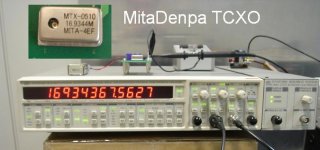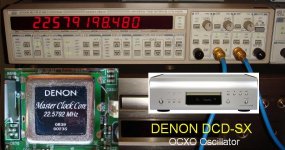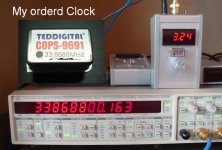bleachershane said:
After what BFNY said, is there any major benefits to clocking the transport from the one master clock through a divider circuit rather than the usual two separate clocks? This way the possibility of separate clock drift could not cause any locking problems?
Yes, avoid more than one clock if possible (integrated CD players are the best in theory), and always place the clock as close as possible to the DAC. Re-clock incoming data as much as feasible. One may synchronize the transport using a PLL inside the transport, if using a 2 box solution. Unfortunately that requires a new interface...... When doing so, always reclock the outging SPDIF at the transport side as well.
cheers
Thanks Guido, I take it the benefits of a single master clock, even in my humble CD-63SE integrated (as opposed to a separate transport/DAC setup) are still worthwhile?
To me it just makes sense that, in basic terms, if two parts of something that has to work together are working off two different points of reference, conflict can occur down the line.
Hmm, time to do some reading up on high speed JK flip flop divider circuits!
To me it just makes sense that, in basic terms, if two parts of something that has to work together are working off two different points of reference, conflict can occur down the line.
Hmm, time to do some reading up on high speed JK flip flop divider circuits!
Nonsense Measurement of Clock diviation No.1
This is so called "+/-1ppm TCXO" MTX-0510 MitaDenpa clock diviation.
If you would like to tuning frequency, please use +/-5ppm trimer controll. But room temprature must fix.
http://www.ne.jp/asahi/sound.system/pract/cont_frame2.html
http://www.ne.jp/asahi/sound.system/pract/self_t_ev/ClockChg.htm
And if you change X'tal oscillator of DENON DCD-S1, please be careful not to be wrong part.
This is failure example of clock exchange.
http://www.fsinet.or.jp/~pcm-s1/2clock.htm
This is so called "+/-1ppm TCXO" MTX-0510 MitaDenpa clock diviation.
If you would like to tuning frequency, please use +/-5ppm trimer controll. But room temprature must fix.
http://www.ne.jp/asahi/sound.system/pract/cont_frame2.html
http://www.ne.jp/asahi/sound.system/pract/self_t_ev/ClockChg.htm
And if you change X'tal oscillator of DENON DCD-S1, please be careful not to be wrong part.
This is failure example of clock exchange.
http://www.fsinet.or.jp/~pcm-s1/2clock.htm
Attachments
Nonsense Measurement of Clock diviation No.2
This is so called by DENON "+/-0.5ppm OCXO" XO6501GG EPSON/TOYOCOM clock diviation.
This OCXO output frequency is controlled by u-com in DCD-SX DENON SACD player.
It is fine diviation! Always it is only slip under 1.5Hz!
And in case of this model, even if you do not worry about room templature, it is all right. Because this is OCXO.
But....
What is the purpose using oven heater controlled OCXO?
I don't hear heater noise.
This is so called by DENON "+/-0.5ppm OCXO" XO6501GG EPSON/TOYOCOM clock diviation.
This OCXO output frequency is controlled by u-com in DCD-SX DENON SACD player.
It is fine diviation! Always it is only slip under 1.5Hz!
And in case of this model, even if you do not worry about room templature, it is all right. Because this is OCXO.
But....
What is the purpose using oven heater controlled OCXO?
I don't hear heater noise.
Attachments
Nagae san,
Very interesting measurements of absolute frequency deviation. As you yourself and others wrote before, this parameter is irrelevant in audio.
However, you mentioned that you measured the phase noise (which parameter IS relevant for us) of several oscillators with HP (Agilent) E5501B test set. Do you have such graphical output of the phase noise vs. frequency in the 10 Hz to 100 kHz range from the oscillators you measured? I am very interested in how does it look like for a "good" audio quality oscillator. Unfortunately very few manufacturers specify the phase noise at 10 Hz from the carrier. They specify at least at 1 kHz or 10 kHz if they do it at all, and I haven't seen such graph over the audio frequency band.
Very interesting measurements of absolute frequency deviation. As you yourself and others wrote before, this parameter is irrelevant in audio.
However, you mentioned that you measured the phase noise (which parameter IS relevant for us) of several oscillators with HP (Agilent) E5501B test set. Do you have such graphical output of the phase noise vs. frequency in the 10 Hz to 100 kHz range from the oscillators you measured? I am very interested in how does it look like for a "good" audio quality oscillator. Unfortunately very few manufacturers specify the phase noise at 10 Hz from the carrier. They specify at least at 1 kHz or 10 kHz if they do it at all, and I haven't seen such graph over the audio frequency band.
Queation & Request?
oshifissan
My English is so poor, I don't understand your question and request. I'm very sorry, please wright again.
And..... May I ask.
Do you have someting your measurement data?
oshifis said:
However, you mentioned that you measured the phase noise (which parameter IS relevant for us) of several oscillators with HP (Agilent) E5501B test set. Do you have such graphical output of the phase noise vs. frequency in the 10 Hz to 100 kHz range from the oscillators you measured? I am very interested in how does it look like for a "good" audio quality oscillator. Unfortunately very few manufacturers specify the phase noise at 10 Hz from the carrier. They specify at least at 1 kHz or 10 kHz if they do it at all, and I haven't seen such graph over the audio frequency band.
oshifissan
My English is so poor, I don't understand your question and request. I'm very sorry, please wright again.
And..... May I ask.
Do you have someting your measurement data?
nagaesan,
Do you have such graphs that can be seen on the computer display here?
http://www.home.agilent.com/agilent/product.jspx?pn=E5501B
I don't have access to such instrument, so I can not measure phase noise.
Can you recommend a commercialy available oscillator, that has very low phase noise at 10 Hz distance from the carrier?
Do you have such graphs that can be seen on the computer display here?
http://www.home.agilent.com/agilent/product.jspx?pn=E5501B
I don't have access to such instrument, so I can not measure phase noise.
Can you recommend a commercialy available oscillator, that has very low phase noise at 10 Hz distance from the carrier?
Post #15
Did you check this my graph? Post #15
I recomend LcAudio XO3, I measured.
But I did not measure recent new clock unit.
**** My question.******
Why 10Hz?
Did you check this my graph? Post #15
I recomend LcAudio XO3, I measured.
But I did not measure recent new clock unit.
**** My question.******
Why 10Hz?
Re: Post #15
dear Mr Nagaesan
As far as I see, you are measuring the absloute accuracy of the clock
This is no indication of the sound quality
please understand this, this is one of the biggest misconceptions in digital audio I have ever seen
It makes no sense to measure absolute frequencies
best
nagaesan said:Did you check this my graph? Post #15
I recomend LcAudio XO3, I measured.
But I did not measure recent new clock unit.
**** My question.******
Why 10Hz?
dear Mr Nagaesan
As far as I see, you are measuring the absloute accuracy of the clock
This is no indication of the sound quality
please understand this, this is one of the biggest misconceptions in digital audio I have ever seen
It makes no sense to measure absolute frequencies
best
I measured clock phase noise also diviation.
My opinion seems like same yours.
nagaesan said:In case of SACD player, the phase noise is important.
Because if clock purelity was worst there are spurious related playback music energy on phase noise, D/A converted analog signal have I/M distortion.
The frequency diviation is not important for audio equipment.
Because if D/A conversion fs frequency shift about +/- 1000ppm, D/A converted analog signal was fast or slow, but human ear cannot notice.
I checked MTX0510, MXO183S and XO3 phase noise with hp E5501B.
My opinion seems like same yours.
Attachments
oshifis said:nagaesan,
Can you recommend a commercialy available oscillator, that has very low phase noise at 10 Hz distance from the carrier?
**** My question.******
Why 10Hz?
I think 100Hz to 1kHz band phase noise is also important.
If the clock unit GND is shaken servo noise of CD player, it will appear these band.
And if the clock power supply has big ripple noise, it will also appear 100Hz to 10kHz band.
The title of clock diviation No1 to No3 with Rubidium Atomic Clock counter "Stanford Reserch Systems SR625" was this.
"Nonsense Measurement" of Clock diviation
"Nonsense Measurement" of Clock diviation
nagaesan said:The title of clock diviation No1 to No3 with Rubidium Atomic Clock counter "Stanford Reserch Systems SR625" was this.
"Nonsense Measurement" of Clock diviation
🙂
do you have reference or link to this article ?
all the best
Now what about the noise performance of a plain oscillator versus a temperature controlled oscillator?
Why aren't they widely used in audio?
Why aren't they widely used in audio?
Re: I measured clock phase noise also diviation.
see measured results from my 33.8688 MHz XO, looks a bit better (much cheaper, sorry, couldn't resist)
best
Guido
nagaesan said:
My opinion seems like same yours.
see measured results from my 33.8688 MHz XO, looks a bit better (much cheaper, sorry, couldn't resist)
best
Guido
Attachments
Re: Re: I measured clock phase noise also diviation.
Can you explain better why it is better?
Are we looking at how low the noise is at low frequencies?
How quick it falls of as frequency increases?
etc?
Better in what regard?Guido Tent said:
see measured results from my 33.8688 MHz XO, looks a bit better (much cheaper, sorry, couldn't resist)
Can you explain better why it is better?
Are we looking at how low the noise is at low frequencies?
How quick it falls of as frequency increases?
etc?
Re: Re: Re: I measured clock phase noise also diviation.
Yes, lower = better
udovdh said:
Better in what regard?
Can you explain better why it is better?
Are we looking at how low the noise is at low frequencies?
How quick it falls of as frequency increases?
etc?
Yes, lower = better
But now compare a graph where the downslope starts higher but ends deeper versus one that starts deeper than the first one but ends op not as deep as the first one.
I.e.: slope angle differences, `floor` comparisons, etc.
Do we need the integral of the area under the graph? Or what area of the graphis most important?
I.e.: slope angle differences, `floor` comparisons, etc.
Do we need the integral of the area under the graph? Or what area of the graphis most important?
- Status
- Not open for further replies.
- Home
- Source & Line
- Digital Line Level
- 16.9344MHz LOW JITTER CLOCK KIT...




